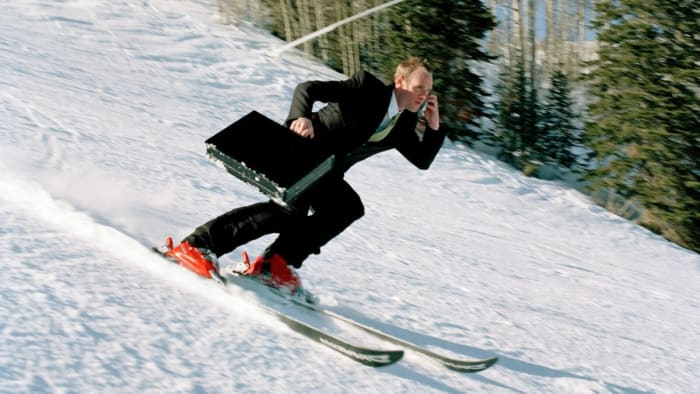As the first storms of the season start to hit the Mountain West and parts of the West Coast, it's hard not to get excited for the impending winter.
Memories of winter's past always fill my brain as I sort through ski gear I haphazardly put away at the end of last season. I wonder how early is too early to wax my skis.
The interest in POWDER's articles about the Farmer's Almanac and La Niña forecasts would indicate that I am not the only one hoping for assurance that winter will deliver, and while all forecasts are a gamble, some are more reliable than others.
"The best we can do is look at some of what we're seeing in the oceans as far as temperature anomalies in different parts, and that can give us some clues on what may be more or less likely for some regions," says OpenSnow forecaster, Alan Smith.
While long-range forecasts are complex and vary more than shorter term forecasts in terms of accuracy, Smith can look at this complex data and tell us more than your average ski bum reading the tea leaves. So, naturally, we asked him a whole bunch of questions.
Keep reading for more predictions about Winter 25/26 from OpenSnow's Alan Smith.
Winter 2025/26 Prediction
So, what does Smith think this upcoming winter will look like?
Right now, he's focused on three factors: a possible weak La Niña, a cold pool of water south of Greenland, and something called a Quasi-biennial oscillation (QBO).
Currently, ocean temperatures have led many forecasters, including Smith, to predict a weak La Niña year, which normally would be a good sign for snowfall across the western US. However, that pool of below-average temperature water in the sub-polar region south of Greenland is different than meteorologists have seen for the last few years.
Past research has shown that when these cold anomalies appear and persist, a dominant trough pattern, or low atmospheric pressure pattern, is often favored over the central and eastern US. In order to balance out that trough, a ridge of high pressure often forms in the western US.
While that trough/ridge set up isn't for sure, that QBO gives Smith another signal that potentially reinforces that forecast. QBO essentially describes winds in the tropics that are close to the equator that have westerly phases and easterly phases that oscillate roughly every 14 to 17 months. Models have shown Smith signals for a strong easterly phase that favors disruptions to the polar vortex, which can further reinforce that eastern trough, western ridge signal mentioned before.
In past years, the combination of cold water south of Greenland and these QBO winds in an easterly phase have overcome a weak ENSO signal, or La Niña, and increased the likelihood of a high pressure ridge in the western US.
Past years with similar patterns have favored drier and warmer weather than normal in California and Oregon (much to the dismay of the POWDER staff, who are predominantly based in these two states).
Depending on where that western ridge sets up, winter could go either way for Washington, Canada, and the Rockies. Depending on the strength and position of the ridge, storms could still slide over the northern and eastern side of the ridge and bring more snow to the other parts of the west. Alternatively, if the ridge is strong and centered far enough east, most of the west could see a drier winter.
None of this information was particularly good news for me, which Smith tried to remedy by saying that it's possible the ridge could build way up north in Alaska and we could still get storms from the south, or the more likely scenario that the ridge is far enough south (sorry, California skiers), that we'd still get storms over the top of it in Oregon.
However, like Smith noted at the beginning of our conversation, it's pretty darn tough to predict things this far out and all of these conflicting pieces of information make for a lower confidence seasonal forecast than usual.
How Accurate Are Long Range Forecasts?
When working out a long range forecast, Smith uses several tools such as NOAA, which has a good model for predicting ENSO behavior (La Niña vs El Niño winters). The International Research Institute for Climate Society also provides a good ENSO model.
Smith's emphasis on ENSO models is due in part to the the fact that ocean temperatures change slower than land temperatures, and have been modeled so much over time that they can be a bit more informative for longer range forecasting.
Smith also looks at historical data to give context to the information he's gaining from current ocean temperatures and other conditions. Climate averages change every 30 years, so he's largely looking at data from 1991 to 2020. Looking at this time frame also helps him factor in recent warm years. It's still tricky to factor climate change into long range forecasts, even using more recent data, because things can vary so much year to year. Places like the Pacific Northwest and New England make it particularly difficult to track those changes with ski areas being closer to the coast and often lower in elevation, making the rain/snow line more of a factor.
The other unexpected piece of data Smith looks at for winter forecasts? Early season snowfall in Siberia. More, heavy snow cover in Siberia in October can cause disruptions to the polar vortex, which can increase the potential for a cold blast down into the central and eastern US especially. However, that cold blast can also reinforce a sharper ridge-trough interface that forms a dip in the jet stream over the US. This pattern isn't particularly favorable for western snowfall but is for eastern snowfall.

Tips for Planning a Ski Trip This Season
With confidence in long-range forecast being, well, not great, how on Earth is one supposed to plan a ski trip in advance?
Smith says if you have the flexibility and finances to plan a last-minute ski trip, that's your best option because you can always look at what resorts are getting the most snow.
Of course, it's tricky for most folks to plan super last minute and flights and hotels can get more expensive the more last minute you book them. In either scenario, but particularly if you have to plan further in advance, Smith recommends choosing somewhere with a high density of ski areas within a two or three hour drive, if possible, so you can pivot plans if a storm comes in further north or south than expected.
"If you're gonna be planning far out in the future, the best thing you could do is to do your research and look at ski areas that tend to have good snowfall at various times of the year," said Smith.
Looking at things like early vs. late season snowfall and terrain aspect can both be helpful and important. "If you're going somewhere that has a lot of south and east facing terrain, you're probably going to want to look at January before the sun gets too strong," he said. In February and March, you might get good storms in those places, but if you get a dry period, snow can get baked quickly if a resort has more sunny aspects.
What Are the Best Places to Ski Over the Holidays?
If you're hoping to ski over the holidays and not sure where to go, Smith has a couple things to keep in mind when choosing a location. "Pick the snow, the areas with the highest snowfall averages for the holidays because you're more likely to have better coverage there," he says.
It's also helpful to consider how steep and rocky a resort is. For example, Jackson Hole is a pretty steep, rocky ski area, so you need a lot of snowfall for good coverage, which isn't always going to happen in December. However, Grand Targhee, on the other side of Teton Pass, isn't quite as steep, so it takes a bit less snowfall to get good coverage.
"Other areas I would probably consider early season that tend to get good snowfall would be Whistler, Revelstoke, or other places up in Canada that tend to get a lot of early storms. The Pacific Northwest, like Mount Baker and probably Mt. Bachelor as well, because they tend to get a lot of good storms in November and December," he said.
In Utah, Alta and Snowbird are usually good earlier season picks, and for those looking to ski Colorado, Steamboat and Wolf Creek are often the best early season bets.
What's New at OpenSnow?
Ahead of the 2025/25 season, OpenSnow is rolling out a few new features so you can stay informed on all kinds of forecasts, not just those unsure, long-range ones. The app will add a 15-day forecast option for its premium users to help skiers plan a little further in advance. As always, the 5 and 10 day forecasts are a bit higher confidence than the 15 day, but it will at least get you an idea.
OpenSnow has also added forecast range charts for premium users. These charts will show what each model used by OpenSnow forecasters are projecting over time as well as a synthesized model with input from OpenSnow forecasters. You can narrow them into 15 day, 10 day, five day, three day, or one day forecasts and even see how much variability there is in projected snowfall for that time period amongst different models.
Check out screenshots of the new features below.
They'll also show liquid equivalent precipitation snow levels, temperature, wind, and wet bulb temperature. "It's a really, really cool feature. It's one of my favorite things that we've added recently and we're starting to show these in the daily snows as well," said Smith.
OpenSnow is also working to build an AI downscale mountain forecast model called Peaks. Peaks will pick up local terrain enhancements or graphic effects to help predict snowfall and mountain environments up to 50% more accurately, especially in micro-climates like that found at Alta, UT or Jay Peak, VT.
Lastly, OpenSnow is working on snow quality and avalanche models to give users even more information about their local snowpack.
More must-reads:
- Travis Hunter, Ashton Jeanty headline list of five disappointing rookies
- NFL rookie report cards 2025: Grading every team’s draft class after seven weeks
- The 'MLB playoff RBI leaders' quiz
Breaking News
Trending News
Customize Your Newsletter
 +
+
Get the latest news and rumors, customized to your favorite sports and teams. Emailed daily. Always free!








